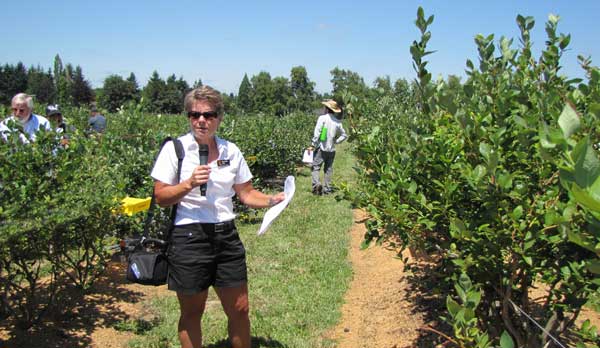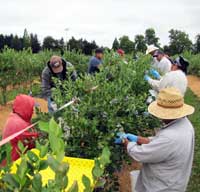
New Research Projects Generating Interest
Among Oregon Blueberry Commission backed research projects are three new ones generating significant interest among blueberry growers.
One involves screening new commercial blueberry cultivars for shock virus resistance. Varietal differences in susceptibility have become more evident in recent years as new plantings come into production, said Jon Umble of Fall Creek Nursery, who is chair of the Commission’s research committee.
“Although it is true that all varieties get shock, there is a huge variation between how fast they get it and how they are affected,” Umble said.
In some varieties, he said, maybe only a few plants are infected after fruiting them for five years. In others, 50 percent of the field may be affected.
USDA Agricultural Research Service (ARS) plant breeder Chad Finn proposed to work on the project partially at the request of the industry.
“If we have some information on the variation in how the different genetics respond to shock, it could help in variety selection in the future,” Umble said.
A second project involves looking for solutions to heat-related fruit damage in highbush blueberries.
Principle researcher for the project is Corvallis-based ARS scientist Dave Bryla.
The issue has been rising in importance in recent years as production of later-season varieties has increased, Umble said.
“With these later-season varieties, the heat comes at the same time the higher-value fruit comes on, and they tend to have continual problems with things like sun scald or soft, which was a big one this year,” Umble said. “Even though we didn’t have a huge heat wave, there were still some very high soft percentages across the Willamette Valley and probably across the whole Northwest.
“We’re starting to look at what our options are for cooling the fruit,” Umble said.
“There is surprisingly little research in Northwest blueberry production about how to do that effectively,” he said.
The third project involves studying insecticide delivery for controlling spotted wing drosophila. The project is in its third year, but this is the first year with backing by the Oregon Blueberry Commission.
To date, researchers in Oregon and Washington have been analyzing the insecticide delivery potential of microsprays that originally were developed as cooling systems. Results are promising, Oregon State University berry crops extension agent Wei Yang said.
Preliminary evaluations comparing microsprays to helicopter sprays show the helicopter sprays tended to stay on the top of the canopy while the microsprays had better penetration, Yang said. “It is much better really than the helicopter in terms of coverage,” Yang said.
Research also is showing that the misting system is providing similar efficacy to air-blast sprayers and is far less damaging to the crop.
Also, researchers now are comparing leaf residue and fruit residue levels between the different spray methods.
“We think that with the misting system, we will end up with lower fruit residue levels,” Yang said.
Field Day Draws Big Crowd
 Attendance for the annual Oregon State University Blueberry Field Day, July 17, was close to a record, said Bernadine Strik, professor of berry crops at OSU. Attendance for the annual Oregon State University Blueberry Field Day, July 17, was close to a record, said Bernadine Strik, professor of berry crops at OSU.
The field day focused on the multi-year organic blueberry project at the North Willamette Research and Extension Center in Aurora.
“We are finding some very valuable results for growers on the best production systems to improve yield and quality,” Strik said.
Strik said growers can expect progress reports this winter.
Researchers plan to start wrapping up the yield and quality portion of the study when the plants are matured next season, which will be their eighth growing season.
“Then our plans are to look further at fruit quality and look at the impact of mulching and fertilizer treatments on plant nutrient allocation,” Strik said. The research involves analyzing root growth and determining how much nutrients plants take up in different production systems, she said.
Strik also reported to field day participants that results on the use of weed mats have looked very promising in the organic production systems.
“We also talked about how ten different varieties that are commercially grown progress in yield and quality as they go from their second growing season through the seventh year,” Strik said.
“We collected our last data for that particular study this year and we will be providing the industry with our results this winter,” she said.
Industry Panel to Rank Research Proposals
In another development, the Commission is expected to advance a proposal on a trial basis this year that involves forming an industry panel to rank research proposals, similar to a process used by the Washington Blueberry Commission. The idea, Umble said, is to get a larger group providing input into the industry’s research needs.
“Although we have a great group of commissioners, it is a small group of people, and there are a lot of growers out there,” Umble said. “Accurately representing the majority of the growers is what we are trying to do.
“I think within our grower base there are some folks that would be really valuable to review proposals, and they would put the time into it, and that type of information would improve our ability to fund things that are most relevant to the industry,” Umble said.
“Hopefully it would make the (research) committee’s discussions a little easier, because we already would have a real good feel for what a broader group of folks think,” Umble said.
|
|
|
